Statistical Analysis of Sun Pharma Drug Testing: A Comprehensive Study
VerifiedAdded on 2023/04/08
|7
|1350
|251
Homework Assignment
AI Summary
This homework assignment focuses on statistical analysis applied to a pharmaceutical company's drug testing data. The assignment begins with an analysis of a new painkiller drug batch, exploring the probability of satisfactory results using binomial distribution and calculating probabilities. It then delves into estimating population means with confidence intervals and performing hypothesis testing to assess drug effectiveness. The assignment requires students to formulate hypotheses, determine significance levels, calculate test statistics, and make decisions based on the results. Furthermore, it examines Type I and Type II errors, discussing conditions under which each would be more critical. Finally, the assignment concludes with an exploration of A/B testing as a method for optimizing marketing campaigns, providing a stepwise procedure for implementation. The assignment demonstrates the application of statistical concepts to real-world scenarios, enhancing the understanding of probability, hypothesis testing, and experimental design.
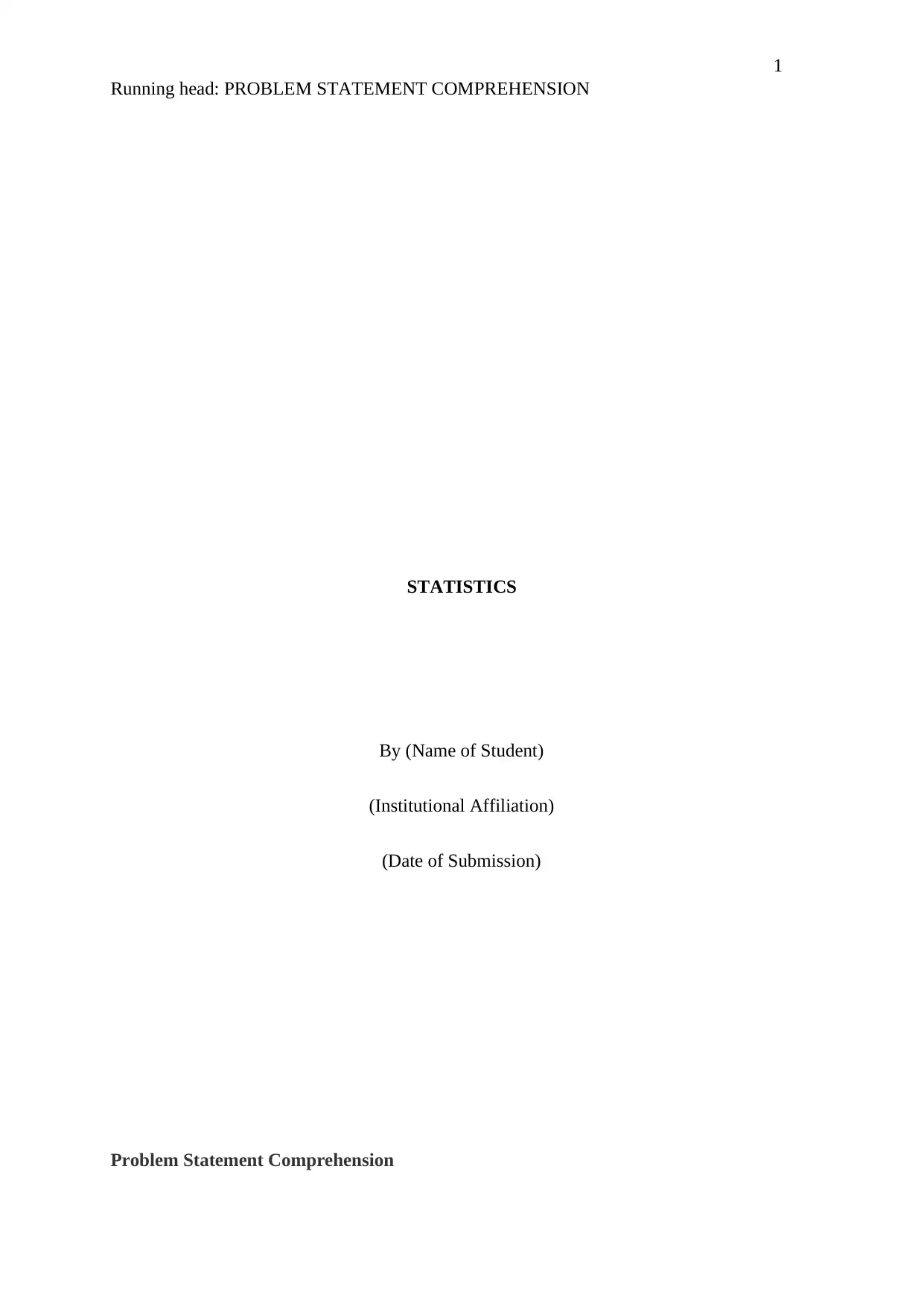
1
Running head: PROBLEM STATEMENT COMPREHENSION
STATISTICS
By (Name of Student)
(Institutional Affiliation)
(Date of Submission)
Problem Statement Comprehension
Running head: PROBLEM STATEMENT COMPREHENSION
STATISTICS
By (Name of Student)
(Institutional Affiliation)
(Date of Submission)
Problem Statement Comprehension
Paraphrase This Document
Need a fresh take? Get an instant paraphrase of this document with our AI Paraphraser
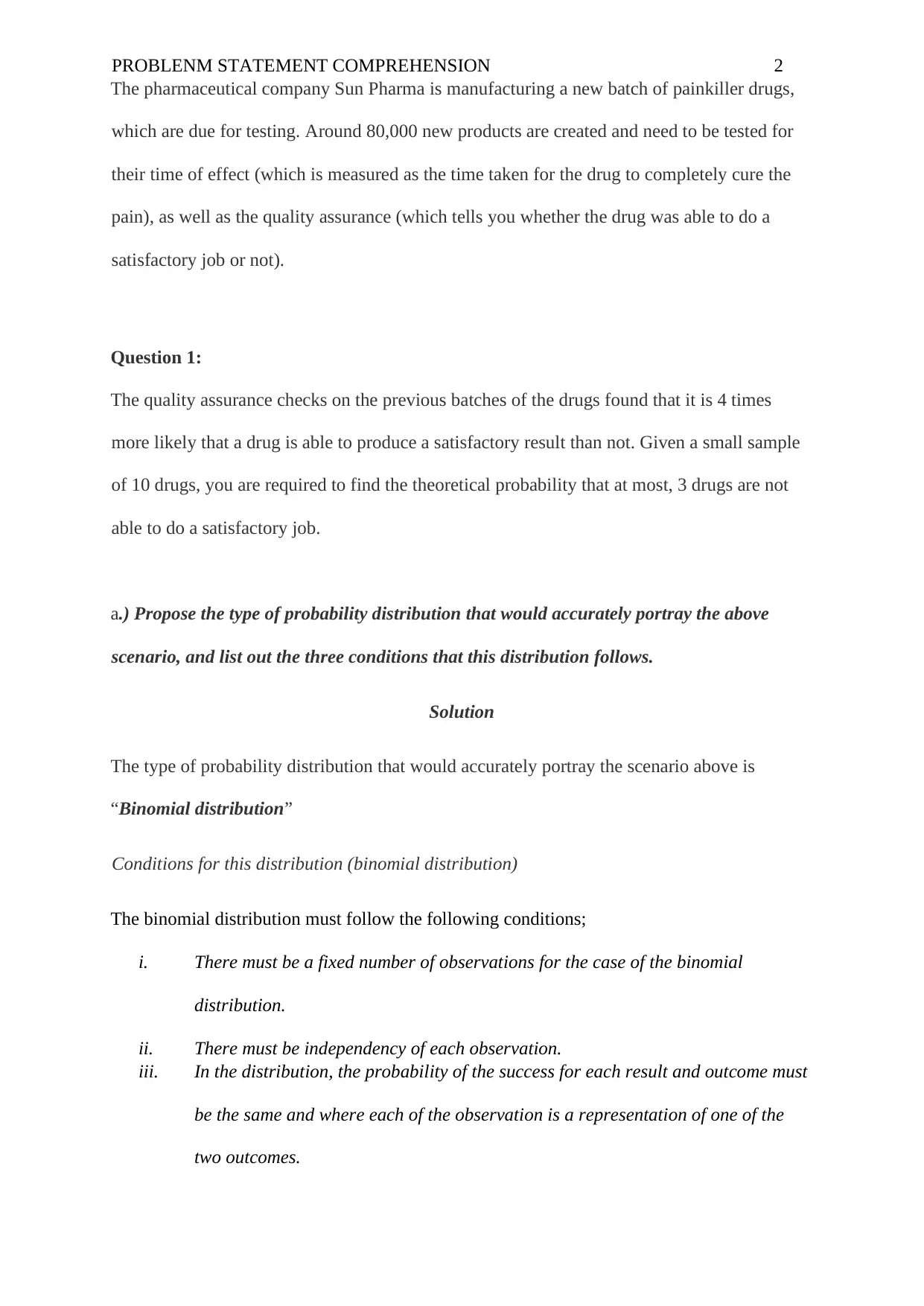
PROBLENM STATEMENT COMPREHENSION 2
The pharmaceutical company Sun Pharma is manufacturing a new batch of painkiller drugs,
which are due for testing. Around 80,000 new products are created and need to be tested for
their time of effect (which is measured as the time taken for the drug to completely cure the
pain), as well as the quality assurance (which tells you whether the drug was able to do a
satisfactory job or not).
Question 1:
The quality assurance checks on the previous batches of the drugs found that it is 4 times
more likely that a drug is able to produce a satisfactory result than not. Given a small sample
of 10 drugs, you are required to find the theoretical probability that at most, 3 drugs are not
able to do a satisfactory job.
a.) Propose the type of probability distribution that would accurately portray the above
scenario, and list out the three conditions that this distribution follows.
Solution
The type of probability distribution that would accurately portray the scenario above is
“Binomial distribution”
Conditions for this distribution (binomial distribution)
The binomial distribution must follow the following conditions;
i. There must be a fixed number of observations for the case of the binomial
distribution.
ii. There must be independency of each observation.
iii. In the distribution, the probability of the success for each result and outcome must
be the same and where each of the observation is a representation of one of the
two outcomes.
The pharmaceutical company Sun Pharma is manufacturing a new batch of painkiller drugs,
which are due for testing. Around 80,000 new products are created and need to be tested for
their time of effect (which is measured as the time taken for the drug to completely cure the
pain), as well as the quality assurance (which tells you whether the drug was able to do a
satisfactory job or not).
Question 1:
The quality assurance checks on the previous batches of the drugs found that it is 4 times
more likely that a drug is able to produce a satisfactory result than not. Given a small sample
of 10 drugs, you are required to find the theoretical probability that at most, 3 drugs are not
able to do a satisfactory job.
a.) Propose the type of probability distribution that would accurately portray the above
scenario, and list out the three conditions that this distribution follows.
Solution
The type of probability distribution that would accurately portray the scenario above is
“Binomial distribution”
Conditions for this distribution (binomial distribution)
The binomial distribution must follow the following conditions;
i. There must be a fixed number of observations for the case of the binomial
distribution.
ii. There must be independency of each observation.
iii. In the distribution, the probability of the success for each result and outcome must
be the same and where each of the observation is a representation of one of the
two outcomes.
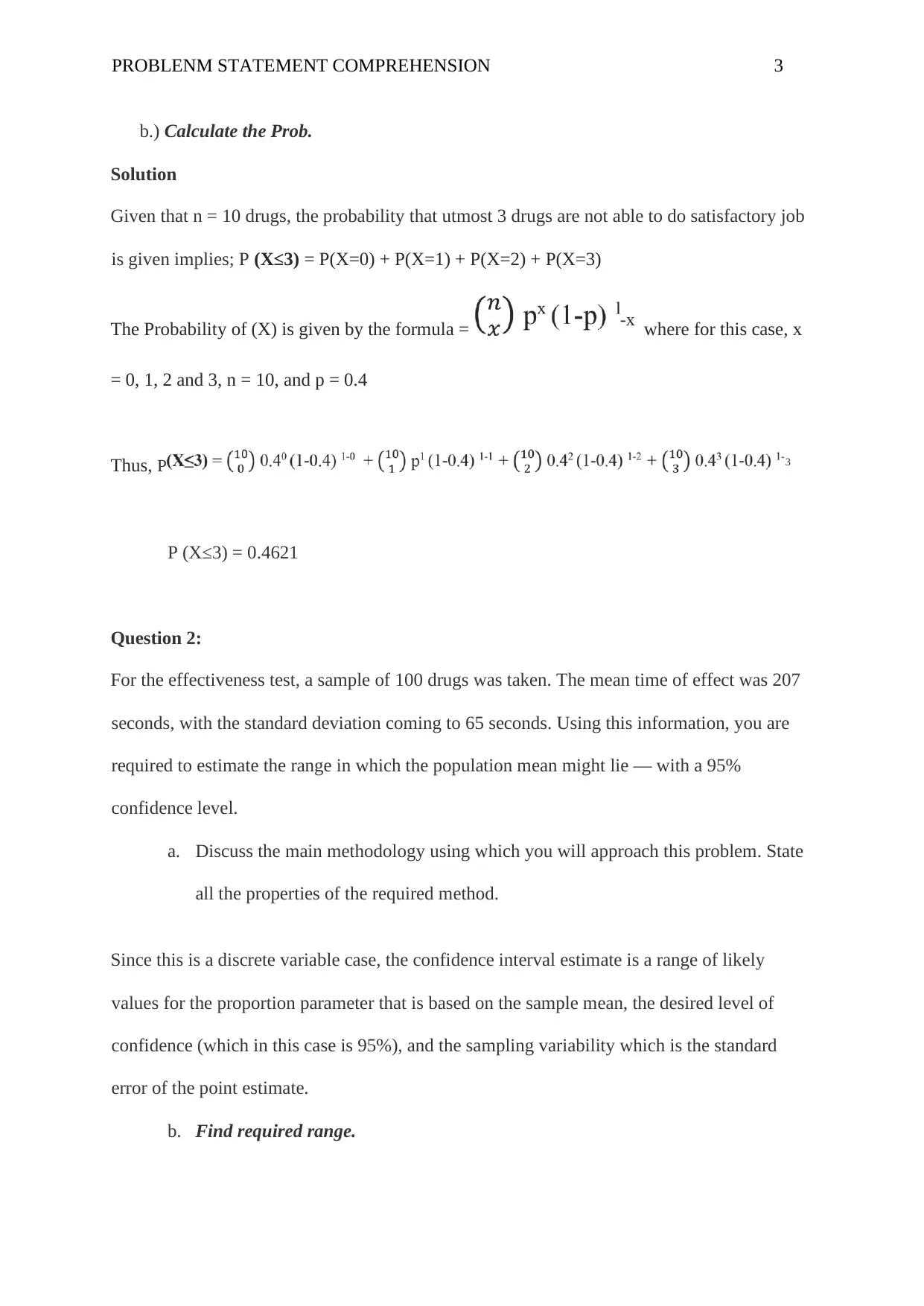
PROBLENM STATEMENT COMPREHENSION 3
b.) Calculate the Prob.
Solution
Given that n = 10 drugs, the probability that utmost 3 drugs are not able to do satisfactory job
is given implies; P (X≤3) = P(X=0) + P(X=1) + P(X=2) + P(X=3)
The Probability of (X) is given by the formula = -x where for this case, x
= 0, 1, 2 and 3, n = 10, and p = 0.4
Thus, P 3
P (X≤3) = 0.4621
Question 2:
For the effectiveness test, a sample of 100 drugs was taken. The mean time of effect was 207
seconds, with the standard deviation coming to 65 seconds. Using this information, you are
required to estimate the range in which the population mean might lie — with a 95%
confidence level.
a. Discuss the main methodology using which you will approach this problem. State
all the properties of the required method.
Since this is a discrete variable case, the confidence interval estimate is a range of likely
values for the proportion parameter that is based on the sample mean, the desired level of
confidence (which in this case is 95%), and the sampling variability which is the standard
error of the point estimate.
b. Find required range.
b.) Calculate the Prob.
Solution
Given that n = 10 drugs, the probability that utmost 3 drugs are not able to do satisfactory job
is given implies; P (X≤3) = P(X=0) + P(X=1) + P(X=2) + P(X=3)
The Probability of (X) is given by the formula = -x where for this case, x
= 0, 1, 2 and 3, n = 10, and p = 0.4
Thus, P 3
P (X≤3) = 0.4621
Question 2:
For the effectiveness test, a sample of 100 drugs was taken. The mean time of effect was 207
seconds, with the standard deviation coming to 65 seconds. Using this information, you are
required to estimate the range in which the population mean might lie — with a 95%
confidence level.
a. Discuss the main methodology using which you will approach this problem. State
all the properties of the required method.
Since this is a discrete variable case, the confidence interval estimate is a range of likely
values for the proportion parameter that is based on the sample mean, the desired level of
confidence (which in this case is 95%), and the sampling variability which is the standard
error of the point estimate.
b. Find required range.
⊘ This is a preview!⊘
Do you want full access?
Subscribe today to unlock all pages.

Trusted by 1+ million students worldwide
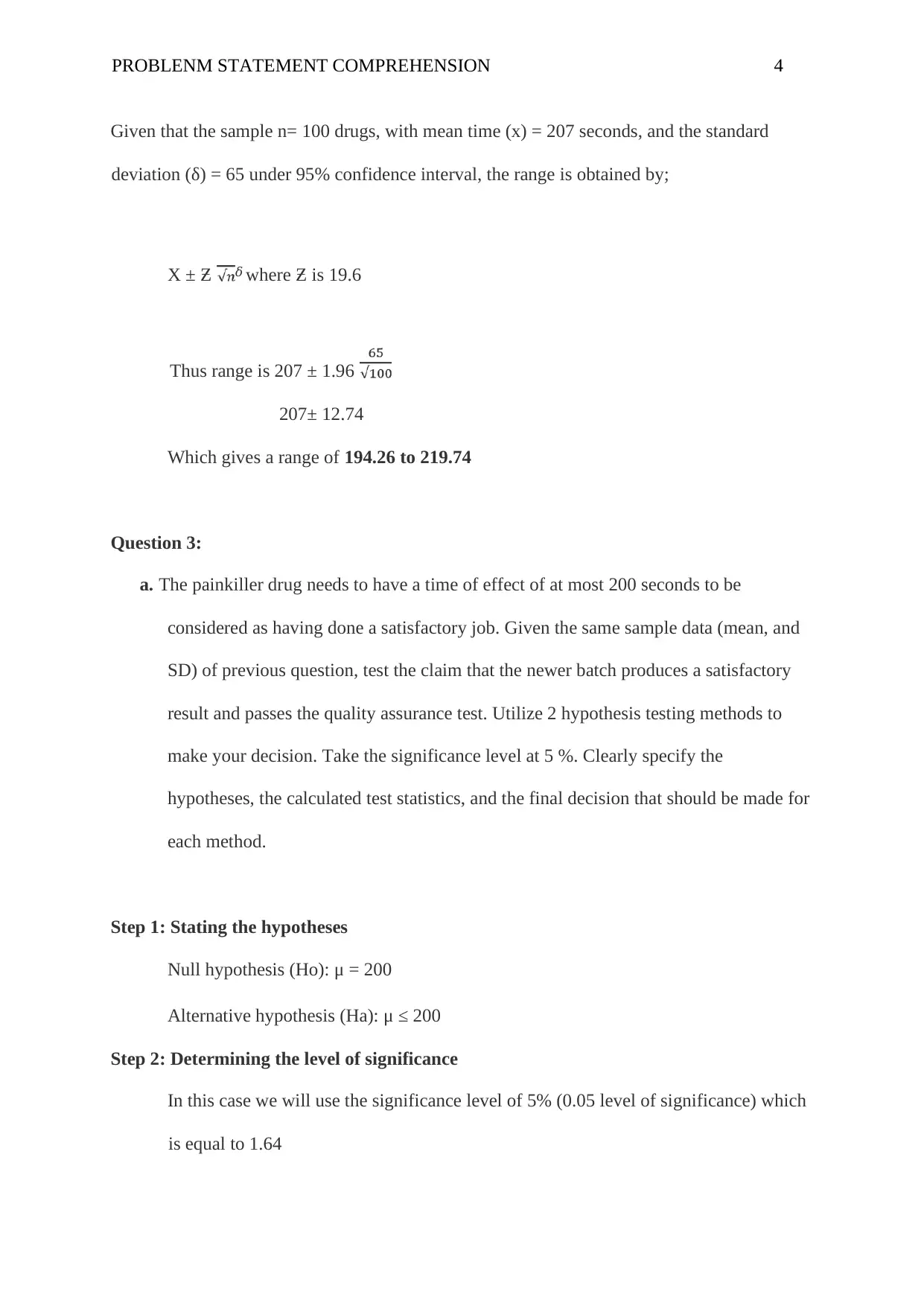
PROBLENM STATEMENT COMPREHENSION 4
Given that the sample n= 100 drugs, with mean time (x) = 207 seconds, and the standard
deviation (δ) = 65 under 95% confidence interval, the range is obtained by;
X ± Ƶ 𝛿 where Ƶ is 19.6
Thus range is 207 ± 1.96
207± 12.74
Which gives a range of 194.26 to 219.74
Question 3:
a. The painkiller drug needs to have a time of effect of at most 200 seconds to be
considered as having done a satisfactory job. Given the same sample data (mean, and
SD) of previous question, test the claim that the newer batch produces a satisfactory
result and passes the quality assurance test. Utilize 2 hypothesis testing methods to
make your decision. Take the significance level at 5 %. Clearly specify the
hypotheses, the calculated test statistics, and the final decision that should be made for
each method.
Step 1: Stating the hypotheses
Null hypothesis (Ho): μ = 200
Alternative hypothesis (Ha): μ ≤ 200
Step 2: Determining the level of significance
In this case we will use the significance level of 5% (0.05 level of significance) which
is equal to 1.64
Given that the sample n= 100 drugs, with mean time (x) = 207 seconds, and the standard
deviation (δ) = 65 under 95% confidence interval, the range is obtained by;
X ± Ƶ 𝛿 where Ƶ is 19.6
Thus range is 207 ± 1.96
207± 12.74
Which gives a range of 194.26 to 219.74
Question 3:
a. The painkiller drug needs to have a time of effect of at most 200 seconds to be
considered as having done a satisfactory job. Given the same sample data (mean, and
SD) of previous question, test the claim that the newer batch produces a satisfactory
result and passes the quality assurance test. Utilize 2 hypothesis testing methods to
make your decision. Take the significance level at 5 %. Clearly specify the
hypotheses, the calculated test statistics, and the final decision that should be made for
each method.
Step 1: Stating the hypotheses
Null hypothesis (Ho): μ = 200
Alternative hypothesis (Ha): μ ≤ 200
Step 2: Determining the level of significance
In this case we will use the significance level of 5% (0.05 level of significance) which
is equal to 1.64
Paraphrase This Document
Need a fresh take? Get an instant paraphrase of this document with our AI Paraphraser
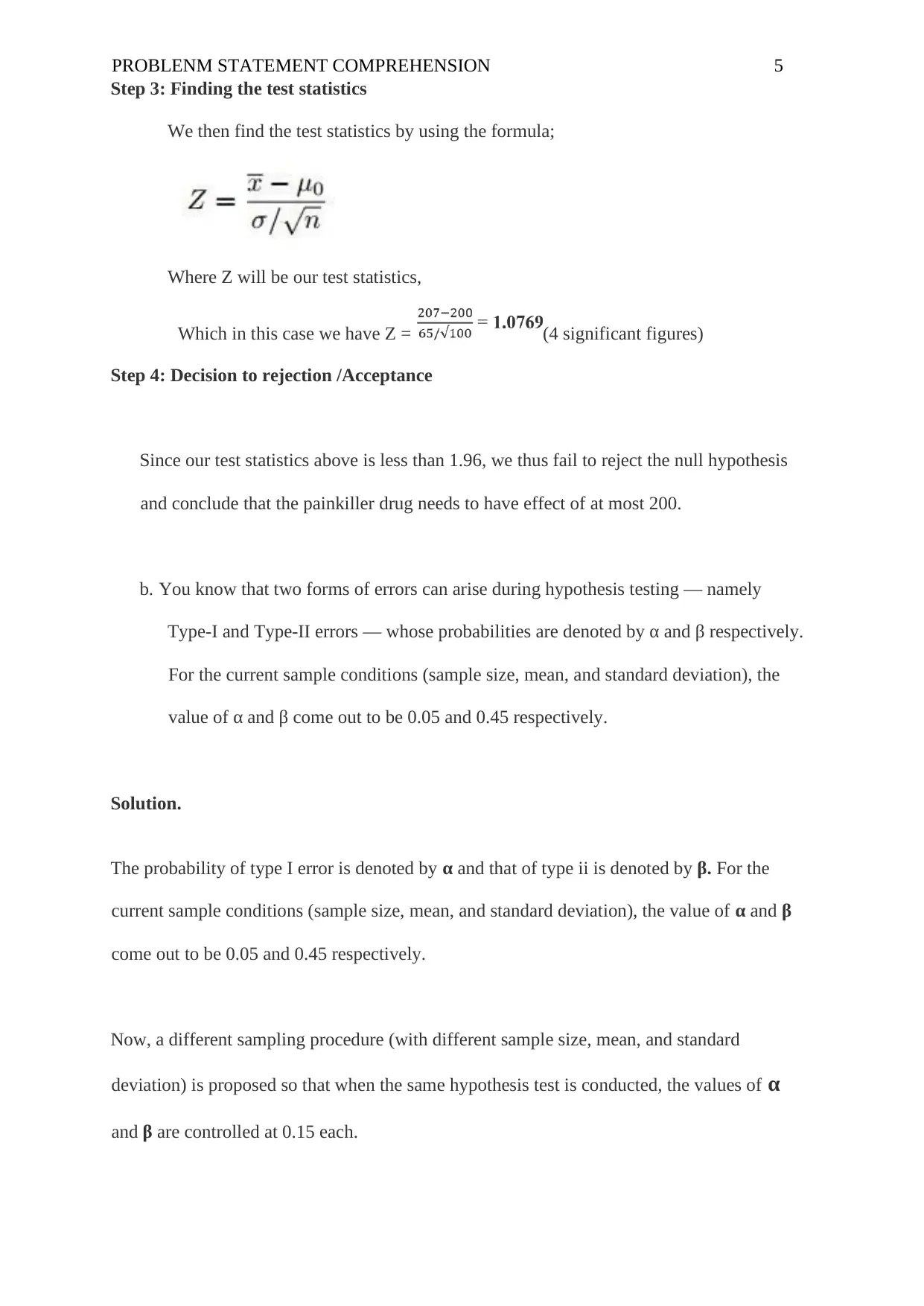
PROBLENM STATEMENT COMPREHENSION 5
Step 3: Finding the test statistics
We then find the test statistics by using the formula;
Where Z will be our test statistics,
Which in this case we have Z = (4 significant figures)
Step 4: Decision to rejection /Acceptance
Since our test statistics above is less than 1.96, we thus fail to reject the null hypothesis
and conclude that the painkiller drug needs to have effect of at most 200.
b. You know that two forms of errors can arise during hypothesis testing — namely
Type-I and Type-II errors — whose probabilities are denoted by α and β respectively.
For the current sample conditions (sample size, mean, and standard deviation), the
value of α and β come out to be 0.05 and 0.45 respectively.
Solution.
The probability of type I error is denoted by α and that of type ii is denoted by β. For the
current sample conditions (sample size, mean, and standard deviation), the value of α and β
come out to be 0.05 and 0.45 respectively.
Now, a different sampling procedure (with different sample size, mean, and standard
deviation) is proposed so that when the same hypothesis test is conducted, the values of α
and β are controlled at 0.15 each.
Step 3: Finding the test statistics
We then find the test statistics by using the formula;
Where Z will be our test statistics,
Which in this case we have Z = (4 significant figures)
Step 4: Decision to rejection /Acceptance
Since our test statistics above is less than 1.96, we thus fail to reject the null hypothesis
and conclude that the painkiller drug needs to have effect of at most 200.
b. You know that two forms of errors can arise during hypothesis testing — namely
Type-I and Type-II errors — whose probabilities are denoted by α and β respectively.
For the current sample conditions (sample size, mean, and standard deviation), the
value of α and β come out to be 0.05 and 0.45 respectively.
Solution.
The probability of type I error is denoted by α and that of type ii is denoted by β. For the
current sample conditions (sample size, mean, and standard deviation), the value of α and β
come out to be 0.05 and 0.45 respectively.
Now, a different sampling procedure (with different sample size, mean, and standard
deviation) is proposed so that when the same hypothesis test is conducted, the values of α
and β are controlled at 0.15 each.
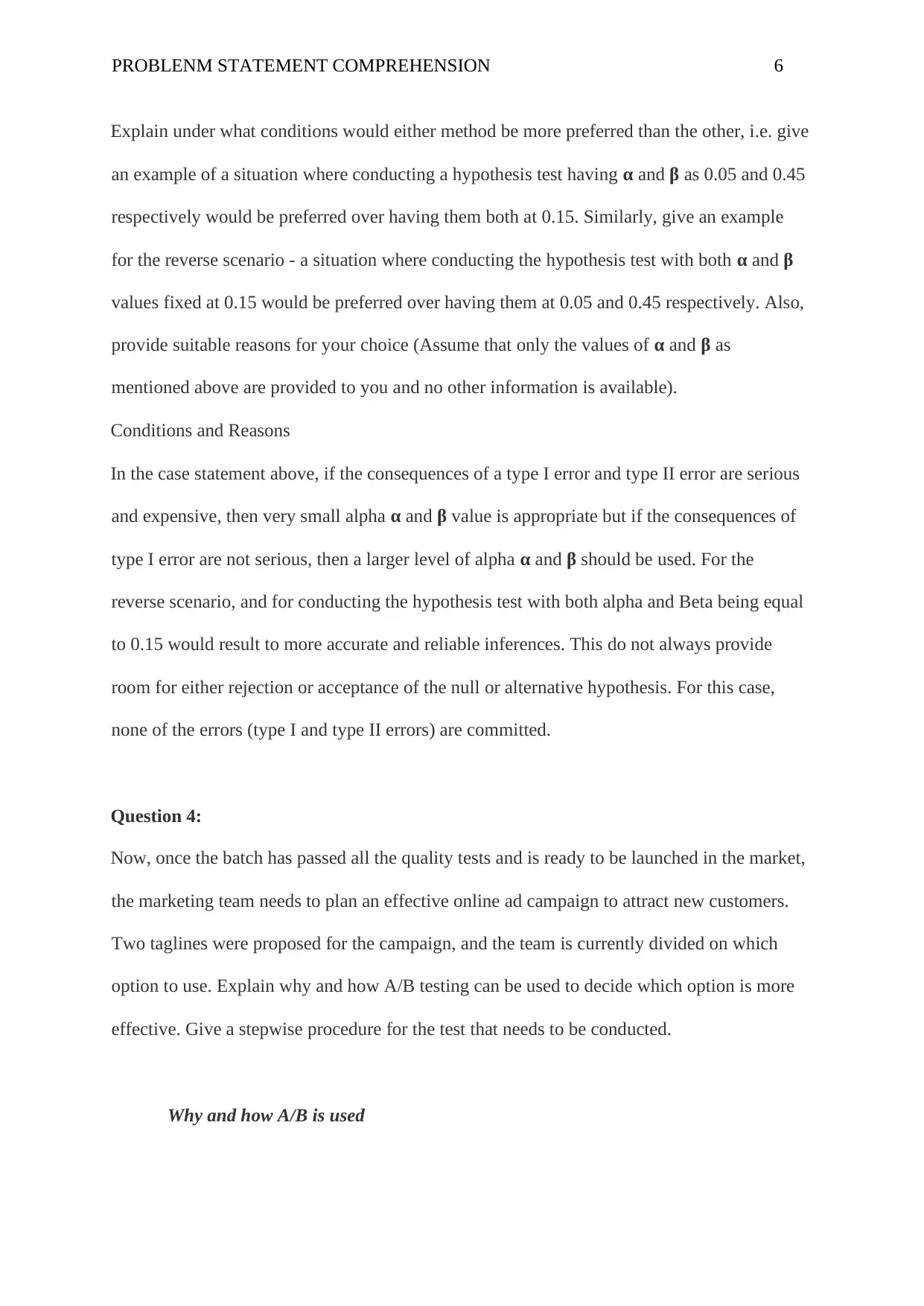
PROBLENM STATEMENT COMPREHENSION 6
Explain under what conditions would either method be more preferred than the other, i.e. give
an example of a situation where conducting a hypothesis test having α and β as 0.05 and 0.45
respectively would be preferred over having them both at 0.15. Similarly, give an example
for the reverse scenario - a situation where conducting the hypothesis test with both α and β
values fixed at 0.15 would be preferred over having them at 0.05 and 0.45 respectively. Also,
provide suitable reasons for your choice (Assume that only the values of α and β as
mentioned above are provided to you and no other information is available).
Conditions and Reasons
In the case statement above, if the consequences of a type I error and type II error are serious
and expensive, then very small alpha α and β value is appropriate but if the consequences of
type I error are not serious, then a larger level of alpha α and β should be used. For the
reverse scenario, and for conducting the hypothesis test with both alpha and Beta being equal
to 0.15 would result to more accurate and reliable inferences. This do not always provide
room for either rejection or acceptance of the null or alternative hypothesis. For this case,
none of the errors (type I and type II errors) are committed.
Question 4:
Now, once the batch has passed all the quality tests and is ready to be launched in the market,
the marketing team needs to plan an effective online ad campaign to attract new customers.
Two taglines were proposed for the campaign, and the team is currently divided on which
option to use. Explain why and how A/B testing can be used to decide which option is more
effective. Give a stepwise procedure for the test that needs to be conducted.
Why and how A/B is used
Explain under what conditions would either method be more preferred than the other, i.e. give
an example of a situation where conducting a hypothesis test having α and β as 0.05 and 0.45
respectively would be preferred over having them both at 0.15. Similarly, give an example
for the reverse scenario - a situation where conducting the hypothesis test with both α and β
values fixed at 0.15 would be preferred over having them at 0.05 and 0.45 respectively. Also,
provide suitable reasons for your choice (Assume that only the values of α and β as
mentioned above are provided to you and no other information is available).
Conditions and Reasons
In the case statement above, if the consequences of a type I error and type II error are serious
and expensive, then very small alpha α and β value is appropriate but if the consequences of
type I error are not serious, then a larger level of alpha α and β should be used. For the
reverse scenario, and for conducting the hypothesis test with both alpha and Beta being equal
to 0.15 would result to more accurate and reliable inferences. This do not always provide
room for either rejection or acceptance of the null or alternative hypothesis. For this case,
none of the errors (type I and type II errors) are committed.
Question 4:
Now, once the batch has passed all the quality tests and is ready to be launched in the market,
the marketing team needs to plan an effective online ad campaign to attract new customers.
Two taglines were proposed for the campaign, and the team is currently divided on which
option to use. Explain why and how A/B testing can be used to decide which option is more
effective. Give a stepwise procedure for the test that needs to be conducted.
Why and how A/B is used
⊘ This is a preview!⊘
Do you want full access?
Subscribe today to unlock all pages.

Trusted by 1+ million students worldwide
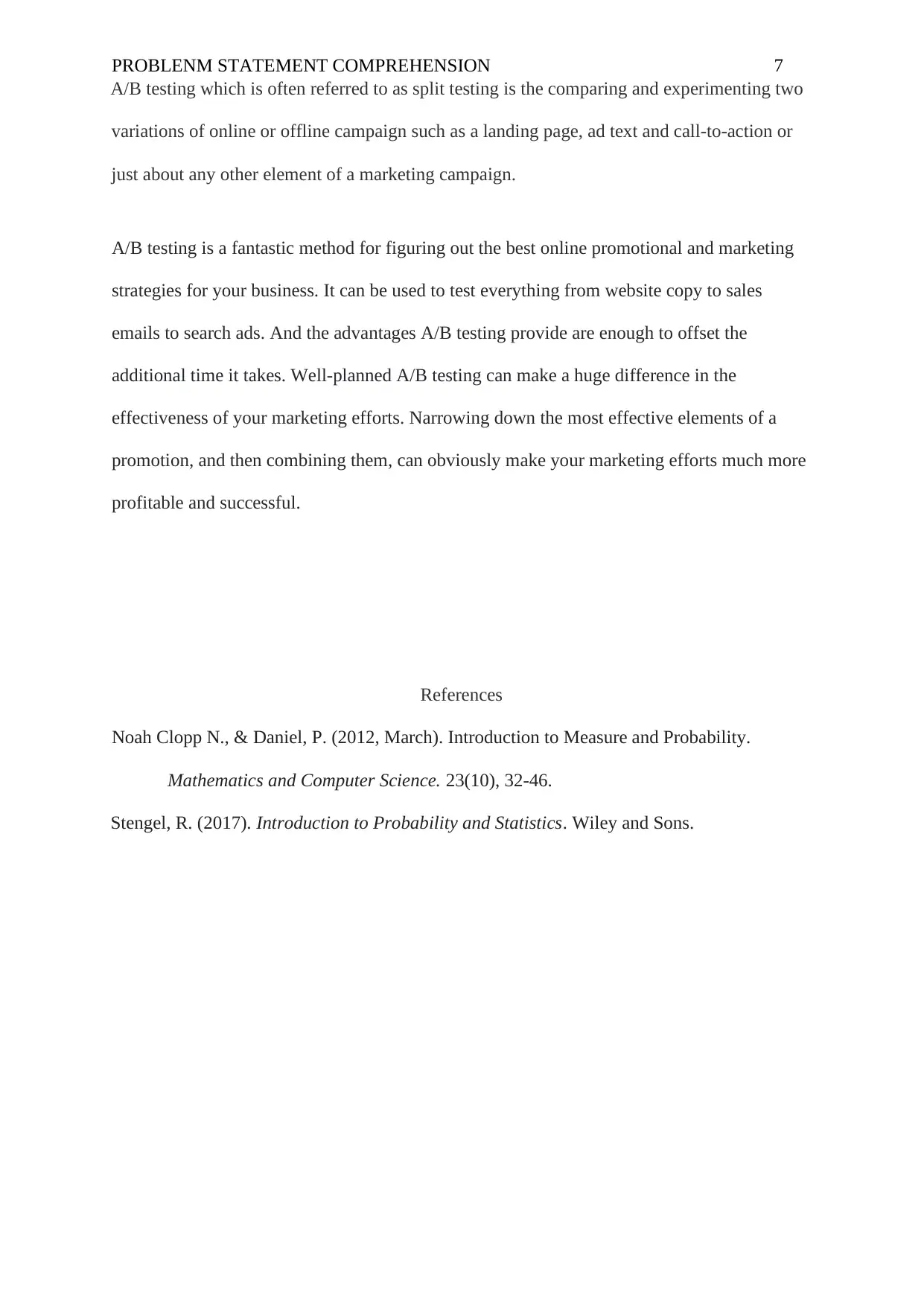
PROBLENM STATEMENT COMPREHENSION 7
A/B testing which is often referred to as split testing is the comparing and experimenting two
variations of online or offline campaign such as a landing page, ad text and call-to-action or
just about any other element of a marketing campaign.
A/B testing is a fantastic method for figuring out the best online promotional and marketing
strategies for your business. It can be used to test everything from website copy to sales
emails to search ads. And the advantages A/B testing provide are enough to offset the
additional time it takes. Well-planned A/B testing can make a huge difference in the
effectiveness of your marketing efforts. Narrowing down the most effective elements of a
promotion, and then combining them, can obviously make your marketing efforts much more
profitable and successful.
References
Noah Clopp N., & Daniel, P. (2012, March). Introduction to Measure and Probability.
Mathematics and Computer Science. 23(10), 32-46.
Stengel, R. (2017). Introduction to Probability and Statistics. Wiley and Sons.
A/B testing which is often referred to as split testing is the comparing and experimenting two
variations of online or offline campaign such as a landing page, ad text and call-to-action or
just about any other element of a marketing campaign.
A/B testing is a fantastic method for figuring out the best online promotional and marketing
strategies for your business. It can be used to test everything from website copy to sales
emails to search ads. And the advantages A/B testing provide are enough to offset the
additional time it takes. Well-planned A/B testing can make a huge difference in the
effectiveness of your marketing efforts. Narrowing down the most effective elements of a
promotion, and then combining them, can obviously make your marketing efforts much more
profitable and successful.
References
Noah Clopp N., & Daniel, P. (2012, March). Introduction to Measure and Probability.
Mathematics and Computer Science. 23(10), 32-46.
Stengel, R. (2017). Introduction to Probability and Statistics. Wiley and Sons.
1 out of 7
Related Documents
Your All-in-One AI-Powered Toolkit for Academic Success.
+13062052269
info@desklib.com
Available 24*7 on WhatsApp / Email
![[object Object]](/_next/static/media/star-bottom.7253800d.svg)
Unlock your academic potential
Copyright © 2020–2025 A2Z Services. All Rights Reserved. Developed and managed by ZUCOL.





